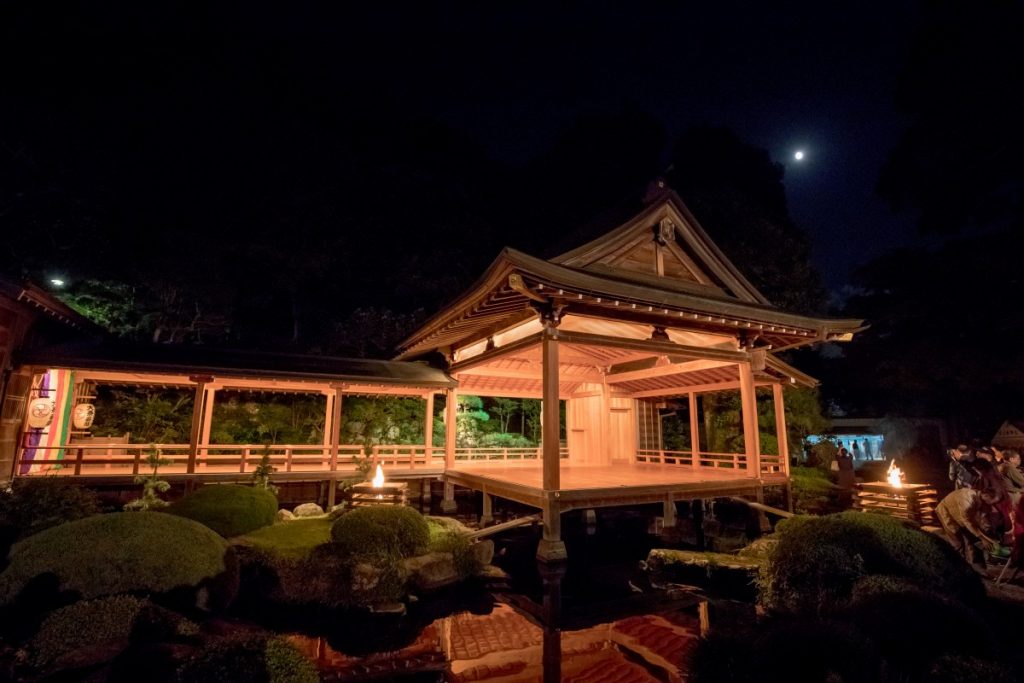Readers of Japan Living Arts are invited to attend special performances of Noh and Kyogen at the Oyama Afuri Shrine on Mt. Oyama in Kanagawa Prefecture. On Oct. 2 and 3, 2019, top actors from the Kanze School of Noh — including Living National Treasures — will share their art outdoors, as Noh was originally performed. There will be an English program and earphone guidance in English providing commentary, making this an excellent opportunity both for those who are new to Noh and seasoned viewers who would like to deepen their appreciation.
Program: Wednesday Oct. 2
OKINA
A sacred rite in which the actors perform divine figures who dance for peace, prosperity, and safety across the land. Performed by Yamashina Yaemon, a Living National Treasure.
AFURI SHRINE KAGURA DANCE
A Shinto ritual dance for the gods performed by shrine maidens.
KYOGEN: HI-NO-SAKE (“The Liquor Pipe’)
Comical theater performed by Yamamoto Tojiro, a Living National Treasure.
NOH: TSUCHIGUMO (“The Ground Spider”)
The shite, or lead roles (the monk and the spider-like monster) are played by Kanze Kiyokazu, the 26th generational hereditary head of the Kanze School of Noh. The role of Minamoto no Raiko, which is a tsure or companion role, is played by his son, Kanze Saburota.
Synopsis: In the first scene, a mysterious monk appears in front of the military commander Minamoto no Raiko, who is feeling ill. The monk hints that he is not what he appears and spins out threads, revealing that he is in fact a spider-like monster known as tsuchigumo. Raiko pulls out a sword by his pillow and attacks but the monk/monster disappears. In the second scene, Raiko’s retainers are assembled at Mt. Katsuragi, intending to hunt down the monster that has threatened their leader. A huge spider emerges from a mound in the ground and attacks again and again with spider threads. A fierce battles ensues but in the end the spider is slayed. This story comes from “The Tale of the Heike,” an epic account compiled prior to 1330 about the struggle between the Taira and Minamoto clans that occurred at the end of the 12th century for control of what is now Japan.
To reserve a seat for this performance with a 500 yen discount for JLA readers and including program and earphone rental (3,500 yen, payment at the door) sign up here:
Program: Thursday Oct. 3
OKINA
A sacred rite in which the actors perform divine figures who dance for peace, prosperity, and safety across the land. Performed by Kanze Yoshinobu.
AFURI SHRINE KAGURA DANCE
A Shinto ritual dance for the gods performed by shrine maidens.
KYOGEN: NEONGYOKU (“Singing in One’s Sleep”)
Comical theater performed by Yamamoto Noritoshi.
NOH: MOMIJIGARI (“Viewing Autumn Leaves”)
The shite, or lead role, is performed by Yamashina Yaemon, a Living National Treasure.
Synopsis: In the first scene, a beautiful lady of seemingly high rank is on an excursion to Togakushi-yama with a retinue of female attendants to see the fall colors. While they are enjoying a banquet, a warrior of the Taira clan who has been out deer-hunting approaches. He is Taira no Koremochi, played by the waki or secondary actor. Rather than disturb the party by riding past, he dismounts, intending to continue on his way. But the lady invites him to drink with her. Koremochi becomes intoxicated as the lady presses drinks upon him. Her dance increases in tempo. When he finally falls asleep, she leaves him in the forest, saying he should never wake from his dream. In the second scene, a deity appears to Koremochi and reveals that the lady is a demon. The deity presents Koremochi with a divine sword and tells him to kill the demon. The lady returns, transformed into a fire-breathing demon. After a pitched battle, Koremochi slays the demon with the sword.
To reserve a seat for this performance with a 500 yen discount for JLA readers including program and earphone rental (3,500 yen, payment at the door) sign up here:
Transportation: The closest station is Isehara on the Odawara Odakyu Line, about one hour from Shinjuku station by regular express trains (590 yen). From the North Exit of Isehara Station, board a bus at bus stop #4 bound for Oyama Cable Car and alight at Shamukyoku- Iriguchi (社務局入口). Fare is 310 yen, IC cards OK. The Noh stage is about 5 minutes walk from the bus stop. There will be extra buses back to Isehara station after the performance.



Comments